

Google. Patent WO1996027002A1 - Novel lipase gene and process for the production of lipase with the use of ... - Google Patents. Patent WO2011081513A2 - Lipase production and purification - Google Patents. Lipase Production and Purification Field of Invention The invention provides a method in producing and purifying extracellular lipase derived from Burkholderia sp.
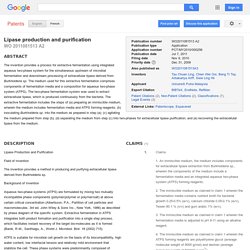
Background of Invention Aqueous two-phase systems (ATPS) are formulated by mixing two mutually incompatible phase components (polymer/polymer or polymer/salt) at above certain critical concentration (Albertsson, P.A., Partition of cell particles and macromolecules. 3rd ed. John Wiley & Sons Inc., New York, 1986) as described by phase diagram of the specific system. ATPS is suitable for microbial cell growth on the basis of its biocompatibility, high water content, low interfacial tension and relatively mild environment that stabilize the cell. Patent EP1905821A1 - Fermentation methods and compositions - Google Patents. Patent US8334130 - Method for producing lipase, transformed Yarrowia lipolytica cell capable of ... - Google Patents. The present application is a 35 U.S.C. §371 National Stage patent application of International patent application PCT/FR06/01352, filed on Jun. 15, 2006.

The present invention relates to a method for producing lipase using Yarrowia lipolytica yeast cells which produce an acid-resistant recombinant lipase, which method allows the production of a lipase capable of being used as a medicament; the present invention also relates to a Yarrowia lipolytica strain overproducing an acid-resistant recombinant lipase and its applications. The foods ingested daily by humans consist mainly of lipids, proteins and sugars. All these constituents undergo, before their absorption, hydrolysis catalyzed by the enzymes of the digestive tract. A deficiency in any of these enzymes can therefore cause digestive disorders and lead to considerable malnutrition. The use of Yarrowia lipolytica for the production of a gene of interest has already been described. Patent EP0789079B1 - Coupling process of fermentation and microbial transformation reaction - Google Patents. Patent EP0384717A1 - Thermostable lipase and its production - Google Patents.
Patent WO1995030744A2 - Lipases with improved surfactant resistance - Google Patents. The present invention relates to methods for modifying lipases in a way that their stability is increased.

It relates more specifically to lipases for use in detergent compositions with improved resistance towards surfactants. Lipases are enzymes capable of hydrolyzing lipids. They are used in a wide range of applications, such as processing of fats and oil, detergent compositions for cleaning purposes and diagnostic reagents. Extracellular lipases (triacylglycerol acylhydrolases, E.C. 3.1.1.3) are produced by a wide variety of microorganisms. Isolated microbial lipases have for example been disclosed in U.S. Examples of the use of lipases from various microorganisms in detergent compositions are given in for instance EP 463100 (Pseudomonas pseudoalcaliσenes) , EP 0218272 (Pseudomonas pseudoalcaliσenes) , EP 0214761 (Pseudomonas cepacia) , EP 0258068 (Thermomvces) and EP 206390 (Pseudomonas chromobacter. 5 T.
Serrano et al., J. Methionine MET M. Brief description of the figures. Patent WO1989001032A1 - Immobilized, positionally non-specific lipase, its production and use - Google Patents. Immobilized, positionally non-specific lipase, its production and use.
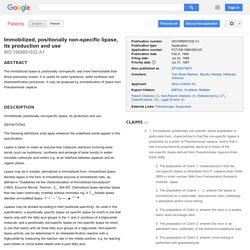
The following definitions shall apply wherever the underlined words appear in this specification. Lipase is taken to mean an enzyme that catalyzes reactions involving ester bonds (such as hydrolysis, synthesis and exhange of ester bonds) in water-insoluble carboxylic acid esters e.g. at an interface between aqueous and an organic phase. Patent EP0571982A1 - Alkaline lipase, method for producing the same, microorganism producing the ... - Google Patents. Patent EP0443063A1 - Pseudomonas lipase gene, vectors for the expression thereof, production of ... - Google Patents. Patent EP0334462B2 - Molecular cloning and expression of genes encoding lipolytic enzymes - Google Patents.
Recovered Patent EP0334462B2 - Molecular cloning and expression. Patent EP0285101B1 - Novel monoglyceride lipase, its production process, and analytical method ... - Google Patents. Patent WO1999042566A1 - Lipase variant - Google Patents. The present invention relates to lipase variants suited for use in detergent compositions, particularly detergents with a high content of anionic surfactant.
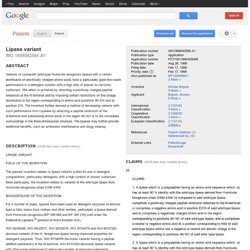
More particularly, the invention relates to variants of the wild-type lipase from Humicola lanuginosa strain DSM 4109. For a number of years, lipases have been used as detergent enzymes to remove lipid or fatty stains from clothes and other textiles, particularly a lipase derived from Humicola lanuginosa (EP 258 068 and EP 305 216) sold under the tradename Lipolase ® (product of Novo Nordisk A/S). WO 92/05249, WO 94/25577, WO 95/22615, WO 97/04079 and WO 97/07202 disclose variants of the H. lanuginosa lipase having improved properties for detergent purposes. Thus, WO 97/04079 discloses variants having a peptide addition (extension) at the N-terminal. WO 97/07202 discloses lipase variants with "first wash performance" which are capable of removing substantial amounts of lard from a lard stained swatch in a one-cycle wash. Patent EP0130064B1 - Improvements in and relating to an enzymatic detergent additive, a detergent ... - Google Patents. [0001] The field of enzymatic additives has been rapidly growing during the last decades.

Reference is made to e.g. the article "How Enzymes Got into Detergents", Vol. 12, Developments in Industrial Microbiology, a publication of the Society for Industrial Microbiology, American Institute of Biological Sciences, Washington, D.C. 1971, by Claus Dambmann, Poul Holm, Villy Jensen, and Mogens Hilmer Nielsen. . [0002] The most common enzymatic detergent additive is a proteolytic additive, but also lipolytic detergent additives are described, e.g. in U.S. Patent EP0384717A1 - Thermostable lipase and its production - Google Patents. Patent EP0285101B1 - Novel monoglyceride lipase, its production process, and analytical method ... - Google Patents. Patent EP1915443A2 - Immobilized enzymes and methods of using thereof - Google Patents.
This application claims the benefit of priority to U.S.

Patent EP0943678A2 - Lipase variants - Google Patents. Patent WO1993020214A1 - Heterologous gene expression in bacillus subtilis: fusion approach - Google Patents. Cross-Reference to Related Applications This application is related to US Application Serial No. 07/800,365 filed November 27, 1991, which is a continuation-in- part of US Application Serial No. 07/600,836 filed October 22, 1990, which is a continuation of US Patent Application Serial No. 07/341,200 filed March 29, 1989, now US Patent No. 4,981,611, which, in turn, is derived from PCT Application Serial No.
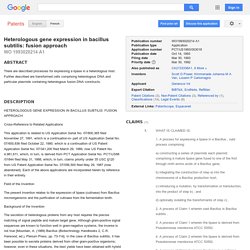
PCT/US88/01844 filed May 31, 1988, which, in turn, claims priority under 35 USC §120 from US Patent Application Serial No. 07/056,500 filed May 29, 1987 (now abandoned). Each of the above applications are incorporated herein by reference in their entirety. Field of the Invention The present invention relates to the expression of lipase (cutinase) from Bacillus microorganisms and the purification of cutinase from the fermentation broth. Background of the Invention The secretion of heterologous proteins from any host requires the precise matching of signal peptide and mature target gene. Patent EP0812910A1 - Novel lipase gene and process for the production of lipase with the use of ... - Google Patents.
Patent EP0646177B1 - HETEROLOGOUS GENE EXPRESSION IN $i(BACILLUS SUBTILIS): FUSION APPROACH - Google Patents. [0001] This application is related to US Application Serial No. 07/800,365 filed November 27, 1991, which is a continuation-in-part of US Application Serial No. 07/600,836 filed October 22, 1990, which is a continuation of US Patent Application Serial No. 07/341,200 filed March 29, 1989, now US Patent No. 4,981,611, which, in turn, is derived from PCT Application Serial No. PCT/US88/01844 filed May 31, 1988, which, in turn, claims priority under 35 USC §120 from US Patent Application Serial No. 07/056,500 filed May 29, 1987 (now abandoned). Each of the above applications are incorporated herein by reference in their entirety. . [0002] The present invention relates to the expression of lipase (cutinase) from Bacillus microorganisms and the purification of cutinase from the fermentation broth.
Patent US20120258900 - Detergent compositions containing bacillus subtilis lipase and methods of ... - Google Patents. The present application claims priority to U.S.

Patent WO2004067705A2 - Stable lipase variants - Google Patents. The present invention relates to the generation and production of novel thermostable, organic solvent stable and pH tolerant lipase gene variants.
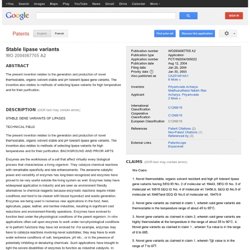
The invention also relates to methods of selecting lipase variants for high temperatures and for their purification. BACKGROUND AND PRIOR ARTS Enzymes are the workhorses of a cell that affect virtually every biological process that characterizes a living organism. They catalyze chemical reactions with remarkable specificity and rate enhancements. The awesome catalytic power and versatility of enzymes has long been recognized and enzymes have proved to be very useful outside the living system as well. In obtaining thermostable enzymes the conventional approach is to screen the microbial collections collected from extremephillic environments (Karsheroff and Ladenstein, 2001).
In view of the environmental safety reasons, there is a constant pressure to reduce the use of environmentally polluting processes in industry. Patent EP0443063A1 - Pseudomonas lipase gene, vectors for the expression thereof, production of ... - Google Patents. Patent WO1993013200A1 - A process for the preparation of lipase - Google Patents. The present invention relates to processes for preparing an active lipase enzyme |π vitro, a DNA construct encoding the lipase, a recombinant vector including the DNA construct, as well as a host cell transformed with the vector. Upases are enzymes which catalyze the hydrolysis of ester bonds in triglycerides resulting in the formation of diglycerides, monoglycerides, glycerin and free fatty acids.
Some lipases also catalyze other reactions involving ester bonds such as synthesis of ester bonds or transesterification reactions. Lipases are produced by a wide variety of different organisms. Microbial lipases in particular are of considerable practical utility for a variety of purposes where lipolysis of fats is desired, e.g. in the food industry and in detergents. One particular lipase which has been found to be particularly advantageous for inclusion in a detergent for the removal of fatty stains or soiling from fabrics is a lipa¬ se produced by strains of Pseudomonas cepacia. Patent US5804409 - Production of active Pseudomonas glumae lipase in homologous or heterologous ... - Google Patents. A genomic library of P. glumae PG1 was constructed in cosmid vector c2RB (Bates and Swift, 1983) maintained in E. coli 1046 (met, gal, lac, hsdR, phx, supE, hsdM, recA). To isolate the lipA gene, the library was screened with radiolabeled mixed probes, based on the NH.sub.2 -terminal amino acid sequence of the P. glumae lipase.
In this way several positive cosmid clones were obtained, one of which was named pUR6000. From this cosmid clone several subclones were prepared, amongst others pUR6001, pUR6002 and pUR6006, which also gave a positive reaction with the radiolabeled mixed probes. The preparation of these plasmids was described more extensively in copending but still unpublished patent specifications EP-A-407 225 and WO-A-91/00920, in which also the complete nucleotide sequence of the lipA structural gene was described. It was found that this gene encodes a lipase-precursor containing an N-terminal extension of 39 amino acids preceding the mature lipase.